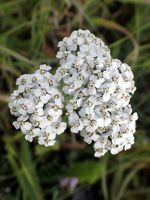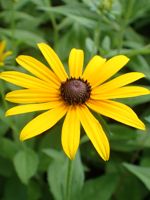Mon-Fri 9am - 5pm Mountain time
Yarrow vs Black-Eyed Susan
Achillea borealis (Previously Achillea millefolium)
Rudbeckia hirta
NOT AVAILABLE THIS SEASON - MIGHT RETURN
Yarrow is a herbaceous, native wildflower that is found across Canada. It features large, flat clusters of tiny white flowers. The blooms attract a variety of pollinators, making it an ideal choice for pollinator gardens. While partial shade is tolerated, the best flowering occurs in full sun. Yarrow is resistant to deer and rabbits, making it both a beautiful and practical addition to your landscape.
The entire plant is edible, but leaves and flowers are most commonly consumed. They have a strong licorice scent and a mild sweet flavor that is similar to tarragon. Yarrow leaves can also be used as a natural insect repellent.
It is important to plant Yarrow in the right place, it can spread quickly via both rhizomes and self-seeding. Deadheading the spent flowers will extend the bloom season and can help limit self-seeding.
Black-Eyed Susan is a striking native wildflower known for its bright yellow, daisy-like flowers with dark center disks. With deadheading, the plant can bloom for an extended period, from mid-summer to early fall. These cheerful flowers attract a variety of pollinators, including bees and butterflies. Adding to its ecological value, the plant also acts as a host for the Wavy-Lined Emerald Moth (Synchlora aerata) and the Silvery Checkerspot (Chlosyne nycteis) butterfly.
While it is typically a short-lived perennial or biennial, the plant freely self-seeds. This allows it to persist in the landscape, particularly in natural areas where it can spread and establish itself. This plant is drought-tolerant, salt-tolerant, and deer and rabbit-resistant, making it ideal for challenging environments. The Black-Eyed Susan is well suited to wildflower gardens, pollinator gardens, as well as slopes, banks, and naturalized areas.
Yarrow Quick Facts
Black-Eyed Susan Quick Facts
Toxicity: toxic to dogs, cats, and horses

